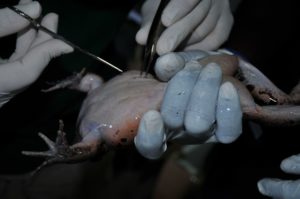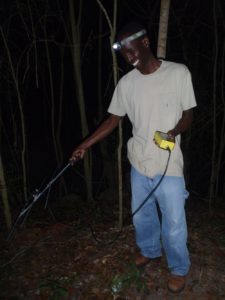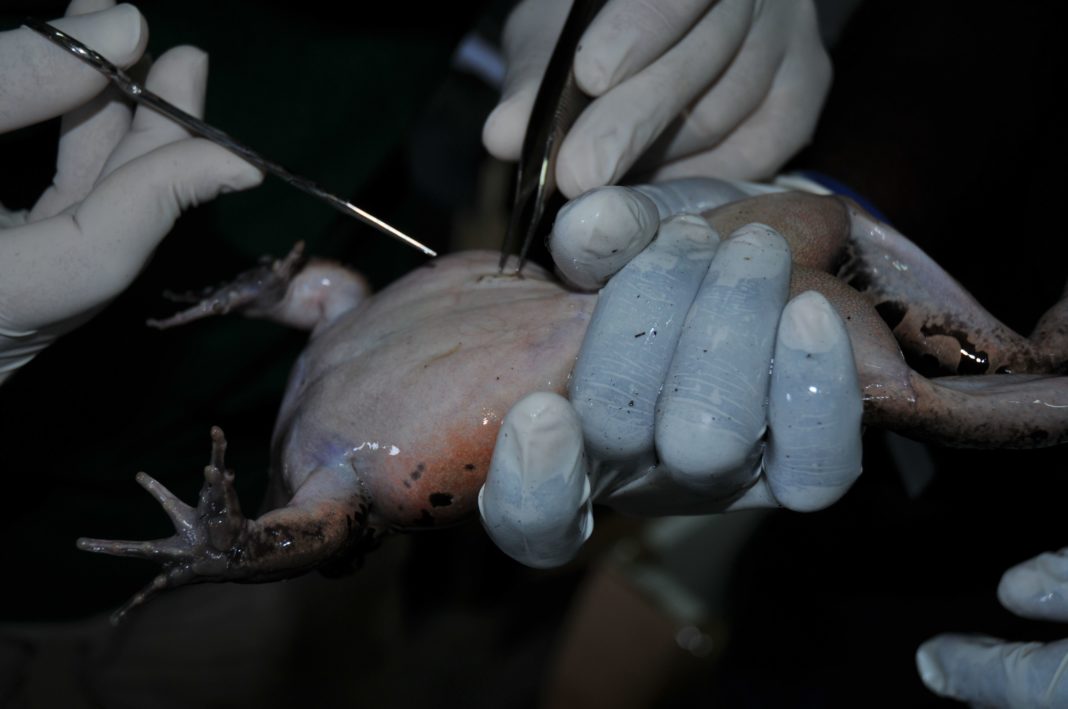From reading this blog, it’s pretty evident that we’ve employed radio tracking as one of the main elements of the release. But, how do we do it? How do the frogs transmit signals? What are the signals like, and what do we do when we pick one up? In this blog we’ll try and answer some of those questions.
So for starters…
How do the frogs transmit signals for us to find?

Durrell ‘super vet’ Javier Lopez surgically implanted tiny transmitters into half of our captive-bred frogs for release. The transmitters have batteries that emit signals we can pick up on our receivers. Each transmitter emits a signal at a unique frequency, so each frog has a different frequency it can be found on; we can tune our receivers in to a particular frog and find it.
What are the signals like and how do we pick them up?
The signals sound like a continuous series of beeps with about a second’s gap between each beep. The beeps have slightly different sounds, but we mainly use the volume of the beeps to determine which direction the strongest beep is coming from, which gives us the general direction of the frog. So, we use our antenna and receiver equipment to pick up a signal for a particular frog, follow the strongest beeps and locate it.
Is it hard to radio track frogs?

It can be! Sometimes signals are really easy to pick up, and other times a complete nightmare. If a frog is hiding down a hole, or underneath a large rock then the signals can be very faint which means sometimes we can’t find them. Signals can also bounce off rocks giving a false sense of where the frog is. Frogs can also move a lot from one day to the next, meaning that we have to search a huge area of forest if the frog isn’t within range of where it was previous time it was tracked and found.
How do you search for missing frogs?
If we have frogs that we can’t find, then we use a series of search points marked on transects to run through the frequencies of any missing frogs. These search points are located no more than 40 m from each other, which is the optimum range for picking up even weak signals so we can be sure to find frogs within the search area.
What do you do when you locate a frog?
Depending on what we’re doing we either catch the frog, swab it for chytrid, visually inspect it for injuries and see if it’s breeding among other things, and take locational data on where we found it. Or, we just take locational data and try not to disturb it too much from its nightly activities.

What happens if the transmitters stop working?
The transmitters only have a limited battery life (about three months), so they can and will fail at some point. Luckily, mountain chickens have a distinctive orange eye shine when you sweep the forest floor with a torch beam. So any frogs that have had their transmitters fail can still be found, but it’s on more of a ‘chance encounter’ basis.
If you have any more questions about our radio tracking, please ask them in the comments section below…
– Isabel Jones







